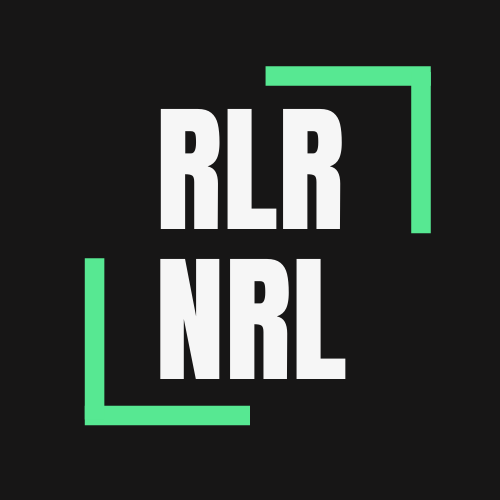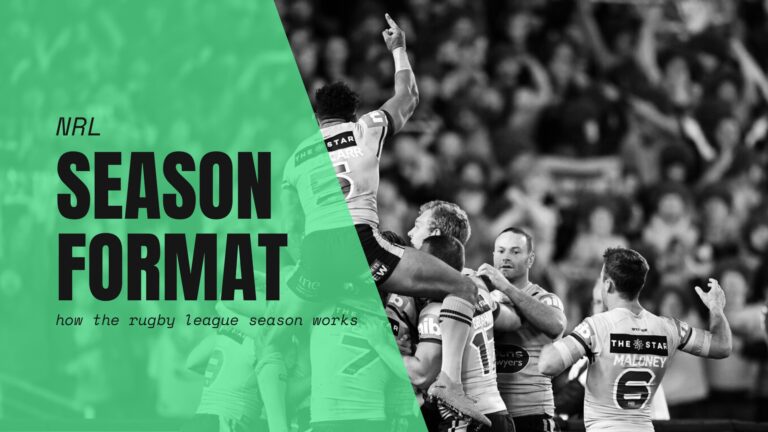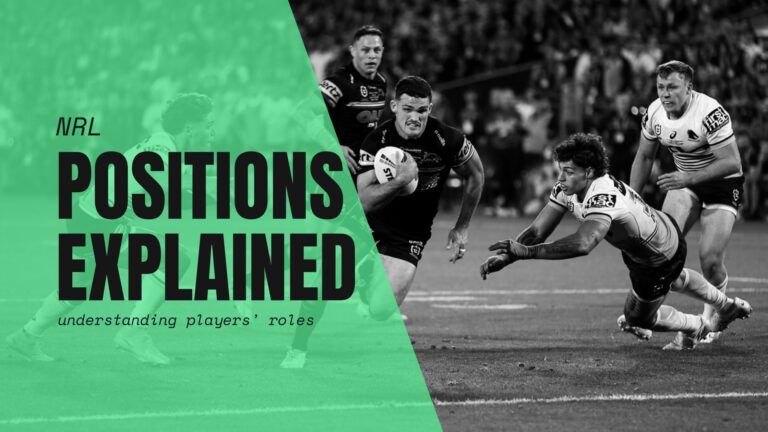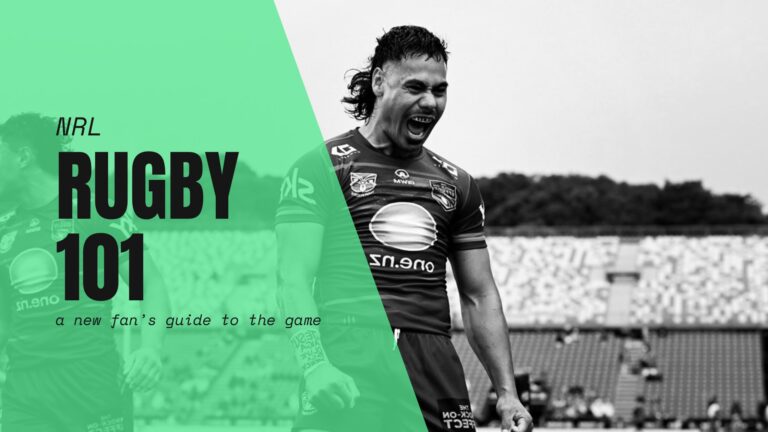A
Ankle Tap
A desperate, last-ditch tackle where a defender dives and clips the attacking player’s heel or ankle to trip them up. If it works, it looks heroic. If it doesn’t… try line.
Attacking Set
A team’s six tackles while in the opponent’s half, usually with a focus on scoring. You’ll often hear “good attacking set” when a team builds pressure close to the try line.
B
Backs
Players wearing jersey numbers 1–7. Generally faster, more agile, and responsible for scoring tries or setting them up. Think wide receivers and running backs.
Ball-and-All Tackle
A tackle where the defender wraps up the attacker and the ball, stopping them from passing or offloading.
Barge Over Try
A short-range power try where a forward crashes over the line, usually from dummy half. No finesse—just brute strength.
Bin / Sin Bin
A 10-minute suspension given for foul play or repeated infringements. The player sits out in the “bin,” leaving their team down a player. It’s the rugby league version of a hockey penalty box.
Bomb
A high, towering kick meant to put pressure on the opposing fullback or winger. Often used on the last tackle. If you’re a fan of chaos, this one’s for you.
Break (Line Break)
When a player gets through the defensive line and into open space. Can lead to a try—or a thrilling footrace.
C
Captain’s Challenge
Each team gets one per game. Used to contest a referee’s decision. If successful, they keep it. If not, it’s gone.
Charge Down
When a defender rushes a kicker and blocks the ball as it’s being kicked. Risky, but can flip the game.
Conversion
A kick at goal after a try, worth 2 points. Taken in line with where the try was scored—yes, even from the sideline.
Crash Play
A short pass to a forward charging at the defensive line, aiming to break through or get close to the try line.
Cross-field Kick
A kick sent from one side of the field to the opposite wing, targeting a leaping winger. Can be a spectacular way to score.
D
Dead Ball Line
The line at the very back of the in-goal area. If the ball crosses this line (on the ground or in the air), play stops. Like going out the back of the end zone in football.
Defending Set
A team’s time without the ball—defending against six tackles. You’ll hear this when talking about whether a team “held strong” or “cracked under pressure.”
Dummy Half
The player who picks up the ball from the play-the-ball. Often the hooker (jersey #9). Quick, smart, and constantly in motion.
Dummy Pass
A fake pass used to fool defenders and create space. If you’re watching and don’t see the ball get passed… it’s probably a dummy.
E
Edge
The part of the field near the sideline, usually involving the second-row forwards, centres, and wingers. Attacking the edge is about exploiting space or mismatches.
Error
Any mistake that causes a turnover: knock-on, forward pass, stepping out, etc. You’ll hear this a lot when teams are under pressure.
F
Fend (or “Don’t Argue”)
A stiff-arm used by a ball-carrier to push away a defender. When done right, it’s brutal and beautiful
Field Goal (Drop Goal)
A one-point kick taken during open play. The ball must hit the ground before it’s kicked. Used late in tight games to edge ahead. If kicked from outside the 40m line, it’s worth 2 points.
Forward Pass
Illegal in rugby league. The ball must always be passed backwards or flat. A forward pass stops play and hands possession to the other team.
Forwards
Players wearing numbers 8–13. Bigger bodies. They do the hard yards, make the tackles, and grind out field position.
G
Grubber Kick
A low, bouncing kick along the ground, usually aimed behind the defensive line. Tough to defend, perfect for chasing attackers.
Think of it as rugby’s version of a sneaky ground ball.
Grounding
To score a try, the ball must be pressed down with control in the in-goal area. Just crossing the line isn’t enough—you have to ground it.
H
Halfback
Wears jersey #7. The main playmaker. Think of them as the quarterback—directs traffic, organizes the attack, makes key kicks.
Held
When the referee calls “held,” it means the tackle is complete and the defender must release the player. Any movement after this doesn’t count for metres.
High Tackle
Any tackle that makes contact above the shoulders. Usually results in a penalty, and sometimes a stint in the sin bin.
Hit-Up
A basic, straight-line run into the defense to gain metres. Mostly done by props and second-rowers. Unflashy—but vital.
I
In-Goal Area
The space between the try line and the dead-ball line. This is the NRL’s end zone—where tries are scored and defending teams can defuse kicks.
Inside Ball
A pass given to a teammate running back inside the play rather than out wide. Used to exploit defenders sliding across too quickly.
Interchange
The NRL’s version of substitutions. Each team gets 10 interchanges per game. Used to manage fatigue and inject fresh energy.
J
Jersey Grab
An attempted tackle where the defender just grabs the jersey—not ideal, and often beaten by momentum. You’ll hear this used critically when a tackle attempt fails.
K
Kick Return
What happens after a team kicks the ball downfield—usually taken by the fullback or winger. Their job? Make metres. Set the tone.
Knock-On
When a player loses control of the ball and it travels forward off their hands or arms. Results in a scrum and turnover.
One of the most common errors in league.
Kick-Chase
The group of players sprinting downfield to pressure the opposition after a kick. The best teams don’t just kick—they chase with purpose.
L
Ladder
The NRL’s name for the standings. Teams are ranked by ladder points (2 for a win, 1 for a draw), with points differential used as a tiebreaker.
Line Break
When a player busts through the defensive line and into open space. Cue the crowd noise.
Line Drop-Out
A type of restart when the defending team is forced back into their own in-goal. The ball is drop-kicked from the goal line, and the attacking team gets possession again.
Loose Carry
When a player drops the ball without being properly tackled. Leads to a knock-on call. Coaches hate it.
M
Mark (The)
The spot where play restarts after a tackle, penalty, or scrum. Defenders must retreat 10 metres from the mark—or risk being called offside.
Metres Gained
A stat showing how many running metres a player or team earns with the ball. Forwards do the grunt work here; backs often bring the big breaks.
Midfield Bomb
A high kick launched from near the centre of the field. Usually used to test the opposing fullback or force an error.
N
Not Square
A penalty called when a defender isn’t directly in line (or “square”) behind the play-the-ball. Usually seen when players try to cheat up early for a tackle.
No Try
The referee’s call when a try isn’t awarded after video review or on-field decision. You’ll hear it often with the Bunker involved (video review system).
O
Offload
A pass made while being tackled—before the ball-carrier hits the ground. Great for keeping momentum and catching defenses off guard. Risky, but when it works? Beautiful.
On Report
When the referee refers an incident (usually foul play) to be reviewed after the game. The player can still be penalized or suspended later.
Onside / Offside
Players must stay behind the play-the-ball or the kicker when chasing a kick. Offside players can’t interfere with play, or it’s a penalty.
P
Penalty
Given for rule breaches like high tackles, offsides, or holding down too long in a tackle. The non-offending team gets a free kick—often used to gain territory or go for a penalty goal (worth 2 points).
Penalty Try
Awarded when the referee believes a try would have been scored if not for foul play. The conversion is automatically awarded—no kick needed.
Play-the-Ball
How every tackle resets. The tackled player gets up and rolls the ball backward with their foot to a teammate (usually the dummy half). No huddle, no reset—just go.
Possession
Who has the ball. With each possession comes a set of six tackles—so it’s a precious thing.
Post-Contact Metres
How many metres a player makes after contact with a defender. A key stat for forwards showing toughness and momentum.
Q
Quick Play-the-Ball
When a player gets up fast and rolls the ball quickly after being tackled—before the defense resets. Helps the attacking team catch defenders off guard and build momentum.
R
Ref’s Call
Used during video review (The Bunker) when the on-field referee’s decision is unclear. The video referee will fall back on the ref’s original ruling unless there’s clear evidence to overturn it.
Ruck
The area immediately around the play-the-ball. It’s where most tackles and collisions happen. Teams try to dominate the ruck to control the pace.
Ruck Infringement
When a defender illegally slows down the play-the-ball—like holding on too long or getting tangled on purpose. Usually results in a set restart (aka “six again”) or penalty.
S
Scrum
A structured restart after a knock-on, forward pass, or accidental stoppage. Players bind together in a formation and the ball is fed in. In the NRL, scrums are mostly symbolic—there’s not much contest for the ball.
Set
A team’s possession of the ball, usually made up of six tackles. You’ll hear phrases like “a good set,” “poor end to the set,” or “they need to complete the set.”
Set Restart (“Six Again”)
Instead of blowing a penalty, the referee can signal a “set restart” for minor infringements around the ruck (like holding down too long). The attacking team immediately gets a fresh count of six tackles. Big momentum shift.
Shift
A play where the ball is passed quickly across the field to stretch the defense and create overlaps. You’ll hear commentators say things like “They shift it left!”—meaning the attacking team is moving the ball laterally through multiple hands to exploit space.
Short Side
The narrow side of the field relative to where the play-the-ball is happening. Attacking the short side often catches defenders off-guard.
Sin Bin (see: Bin)
A 10-minute send-off for foul play or repeated team penalties. Leaves the team a man down.
Sledging
Trash talk on the field. Sometimes playful, sometimes heated. Always part of the theatre.
Sliding Defense
The most common defensive system in rugby league. Each defender starts aligned with an attacker, but as the ball shifts across the field, the entire defensive line slides laterally in sync to cover ground and maintain shape. It’s not strict man-to-man like in football, but players do “mark up” initially and adjust based on the play. Good sliding defense prevents overlaps and forces the attacking team wide—without breaking the line
T
Tackle
The act of stopping the ball-carrier. A tackle is complete when the ball-carrier’s progress is halted and the referee calls “held.” Each team gets six per set.
Tackle Count
How many tackles a team has used in its current set. The ref will shout it out: “Two!” “Five!” and so on. Sixth tackle? Expect a kick.
Tap Restart
A quick restart after a penalty. Instead of kicking for touch, a player taps the ball with their foot and starts running.
Try
The main way to score—worth 4 points. To count, the ball must be grounded with control in the opponent’s in-goal area. No “breaking the plane” here.
U
Under the Pump
When a team is stuck in their own half and constantly defending. You’ll hear this when pressure is building and they’re scrambling to hold on.
V
Video Ref / The Bunker
The NRL’s replay system. Used to review tries, foul play, and other big moments. Sometimes praised, sometimes cursed—but always part of the modern game.
W
Win the Ruck
Controlling the speed of the play-the-ball. Fast play = attacking momentum. Slow play = defensive control. Coaches talk about this constantly.
Winger
Player wearing jersey #2 or #5. Sticks to the sideline. Often the fastest player on the team—and the one finishing spectacular tries.
Wrap-Around Play
A passing move where a player passes the ball, then runs behind the receiver to get it back again. Used to confuse defenders and open up space.
Y
Yardage Set
A set focused on gaining metres—usually starting deep in your own half. Less flashy, more grind. Built to flip field position and lay a platform for attack.
Z
Zero Tackle
If a team regathers a loose ball from a knock-on or penalty kick, the ref may call a “zero tackle.” It gives them six full tackles from that point—like a bonus play to start fresh.



